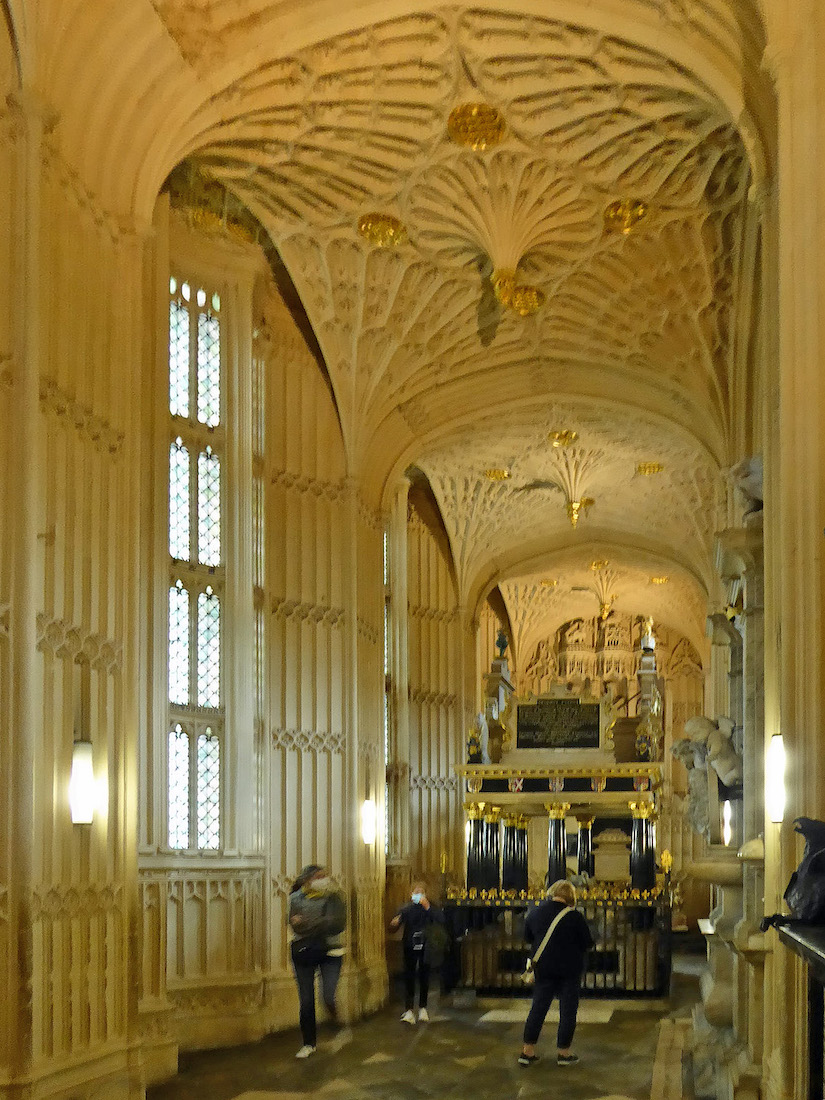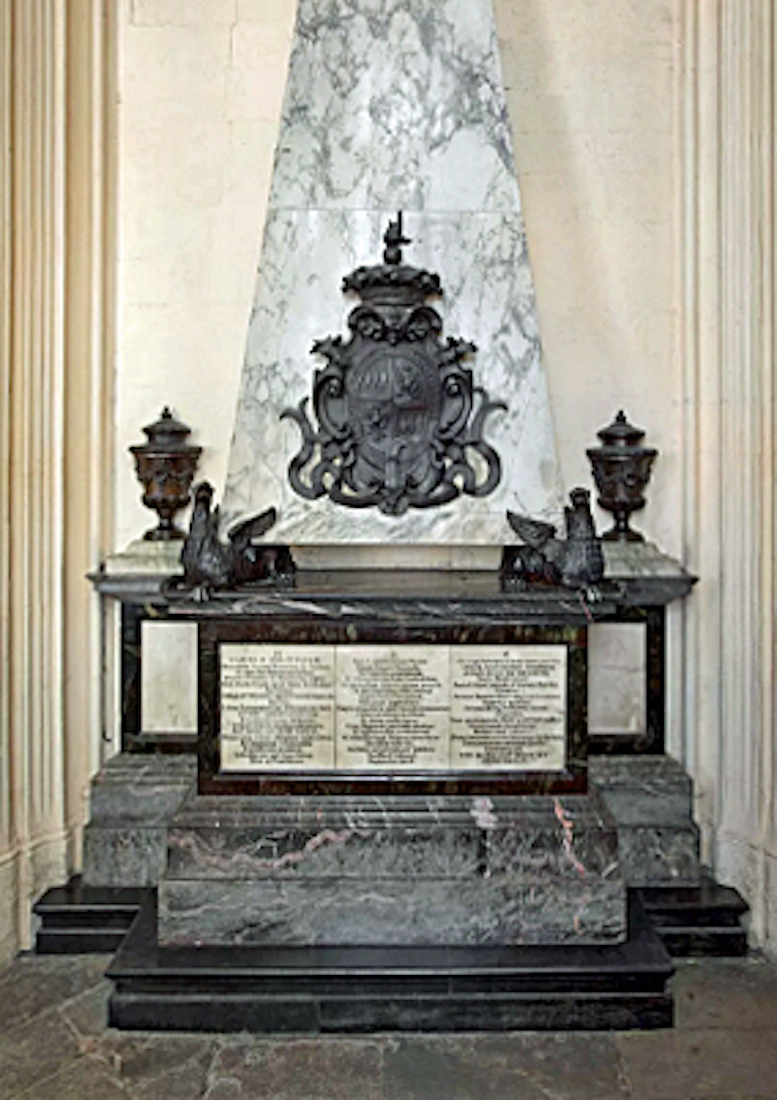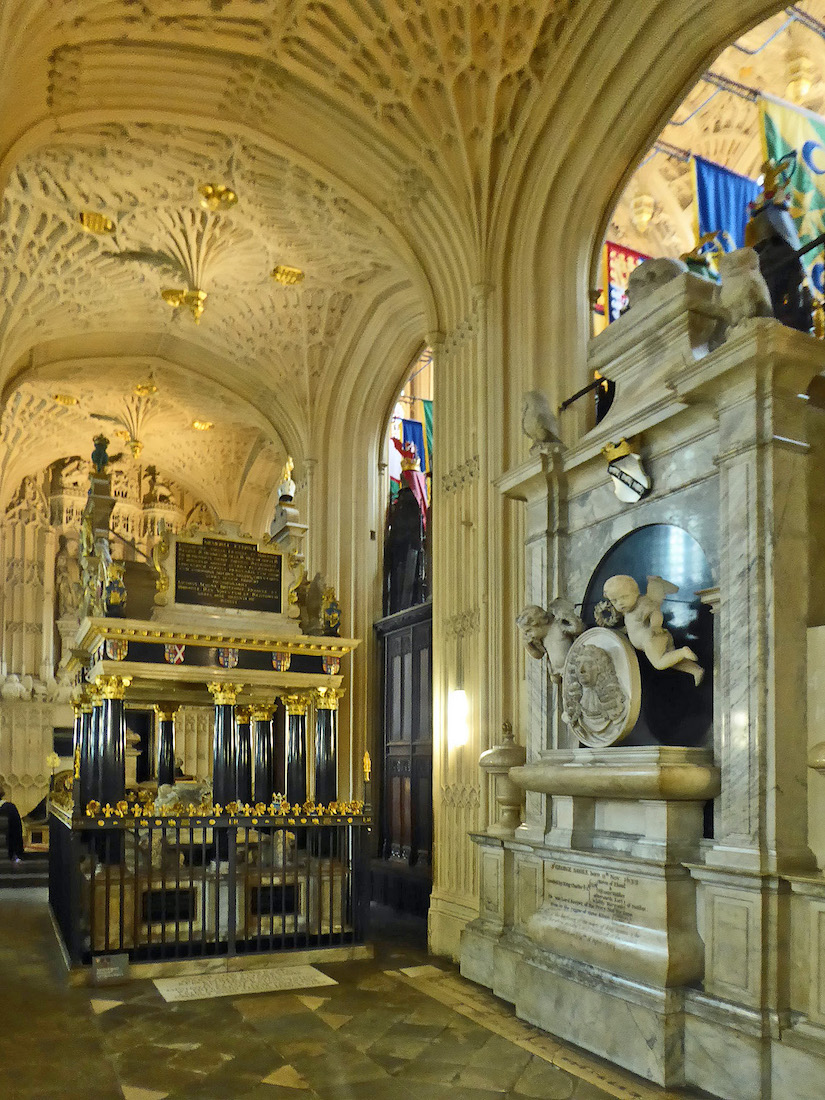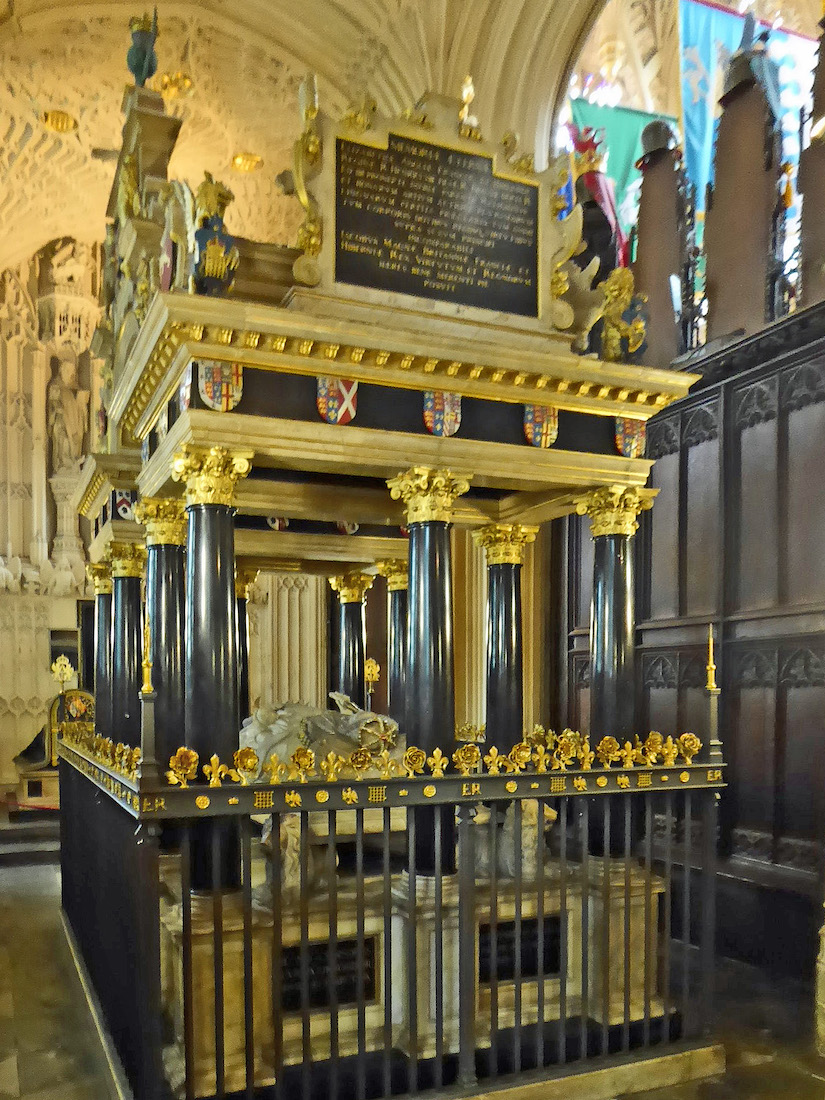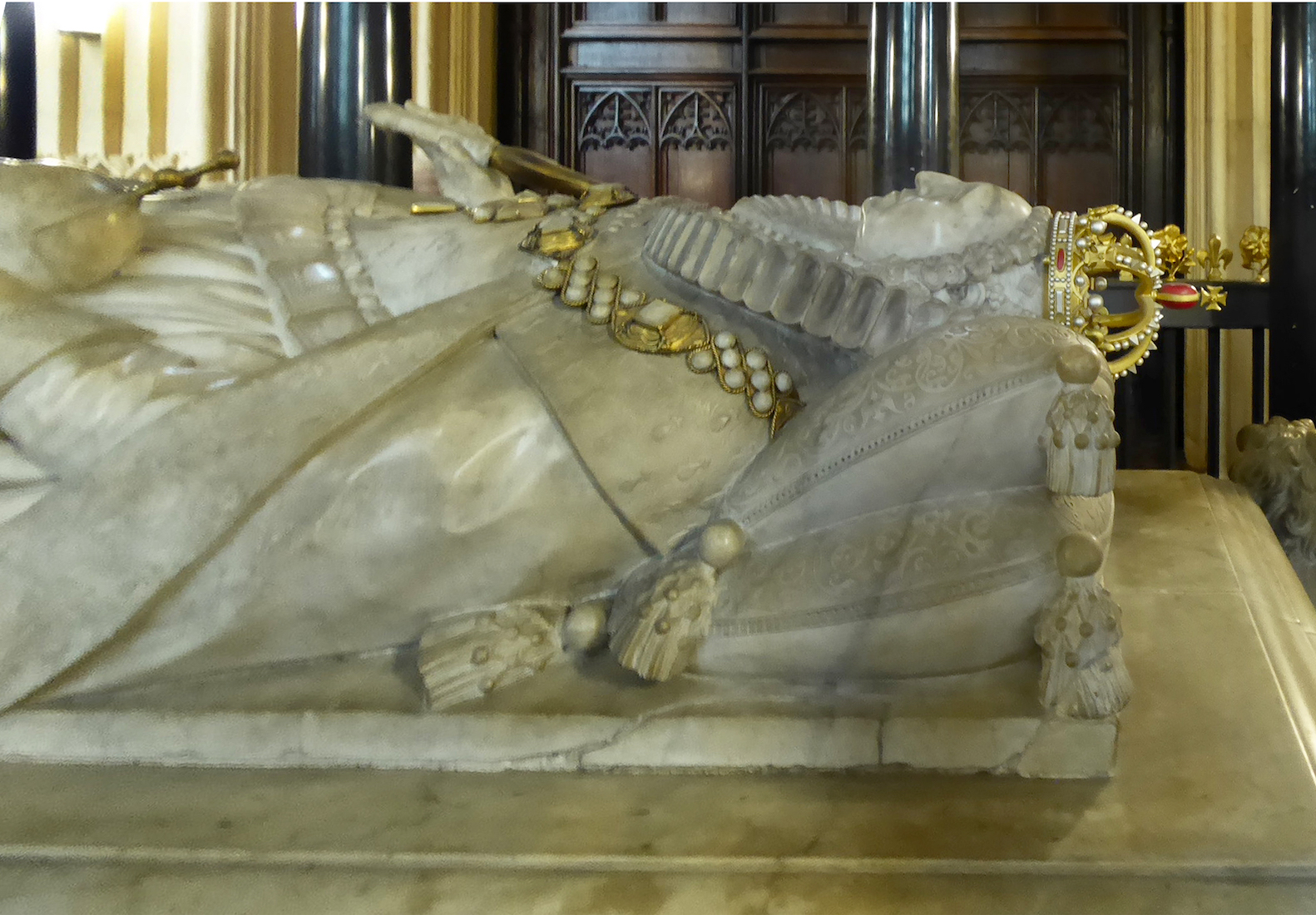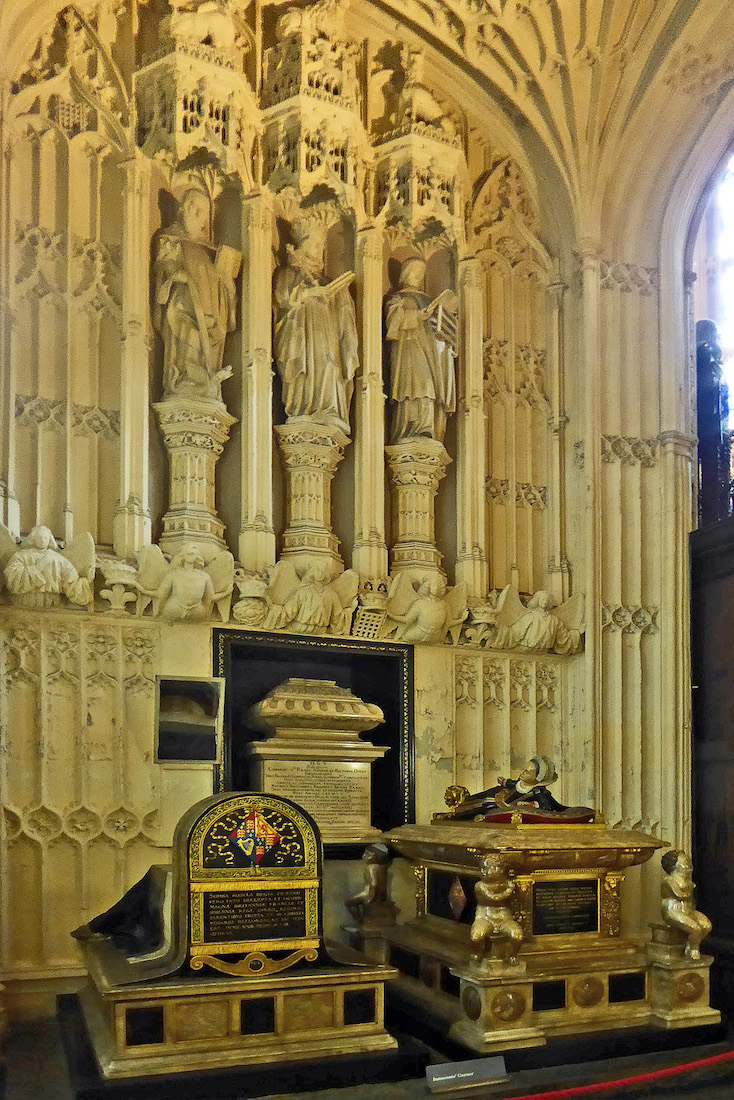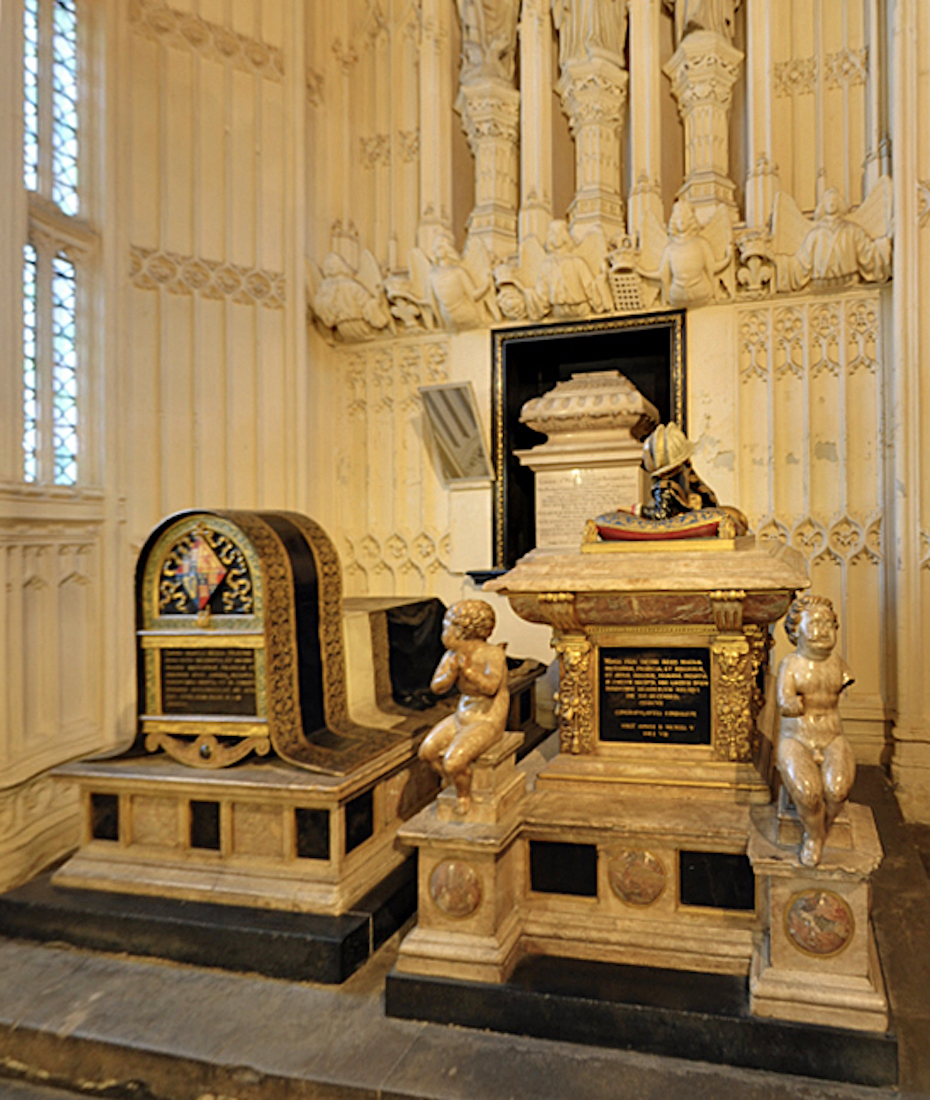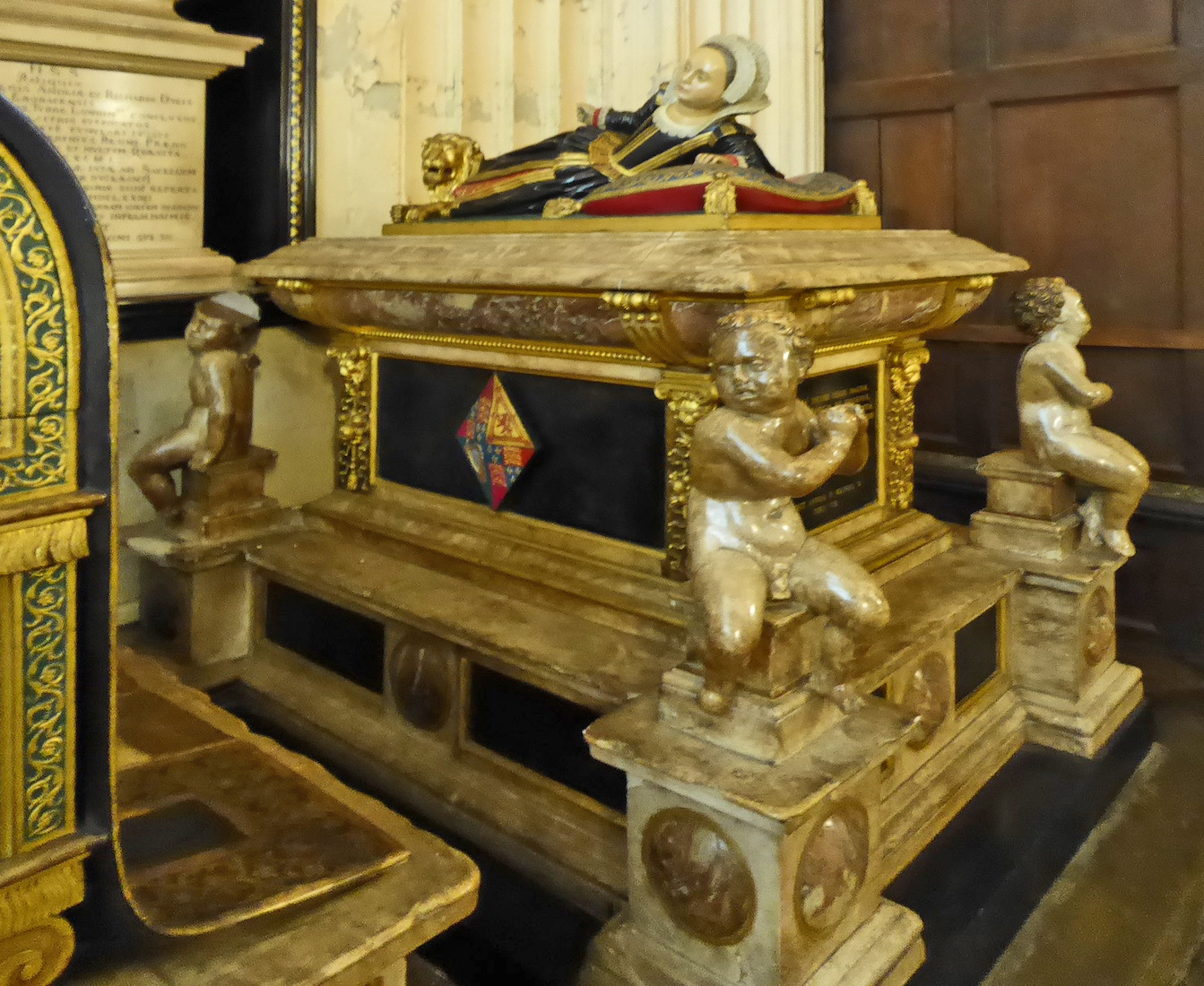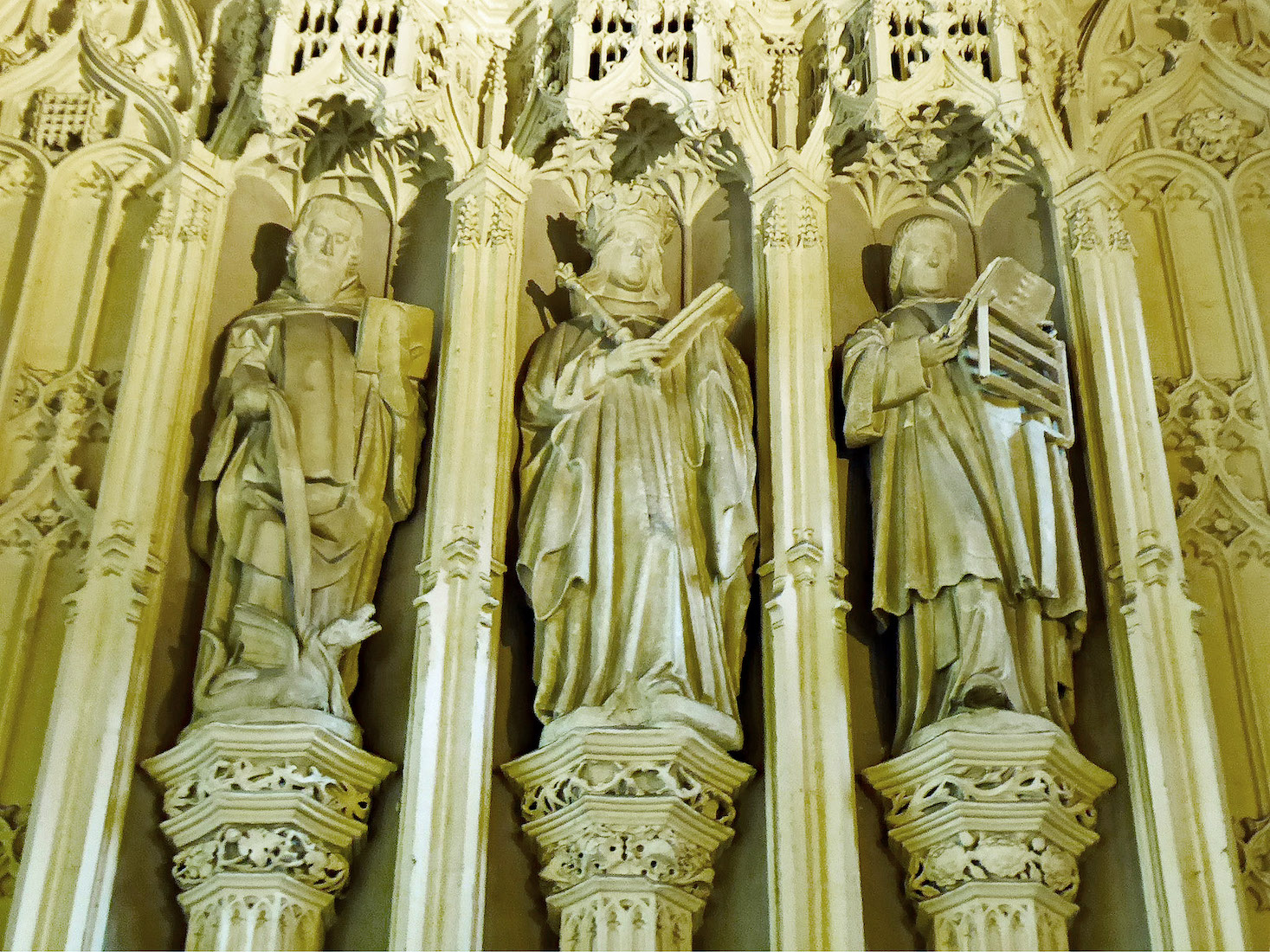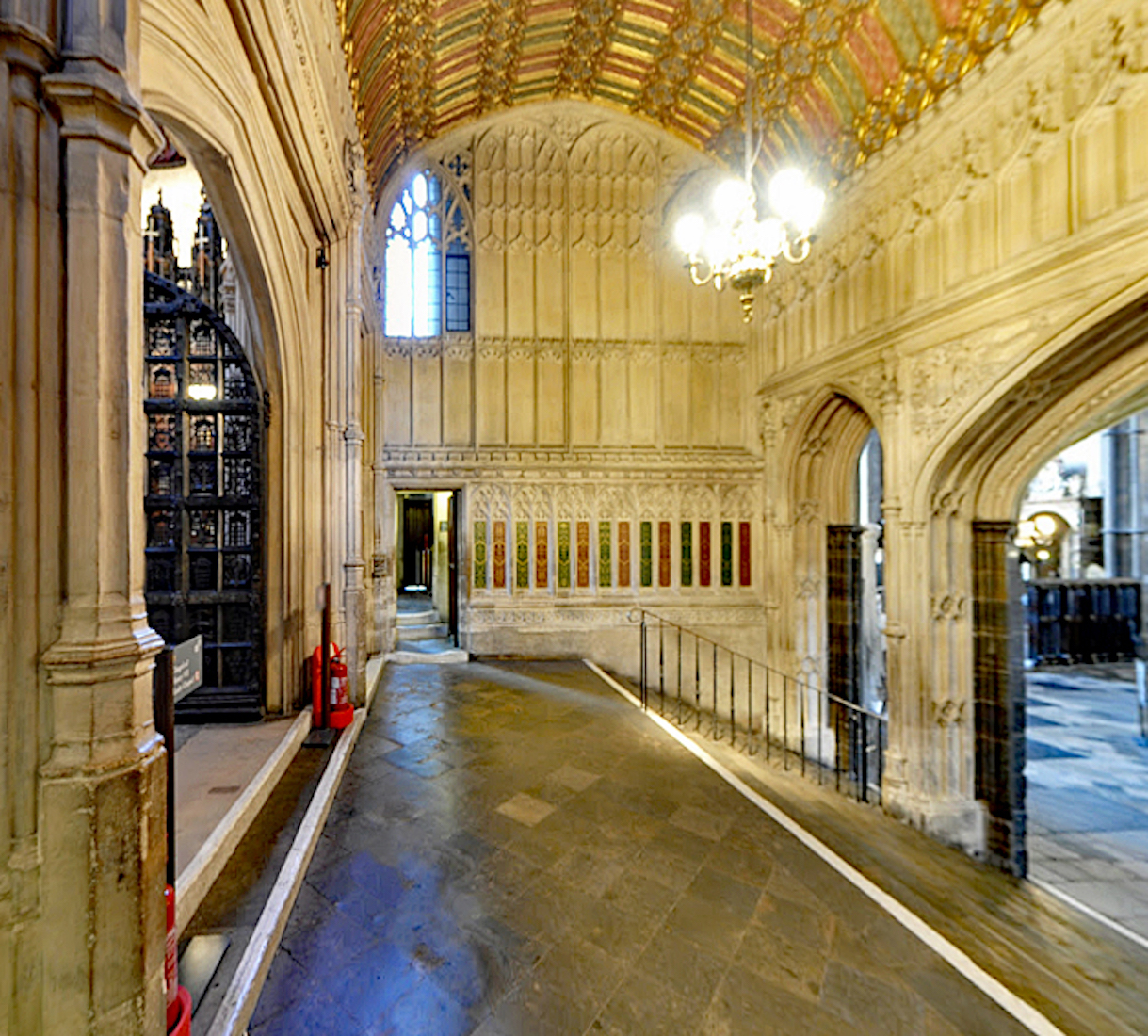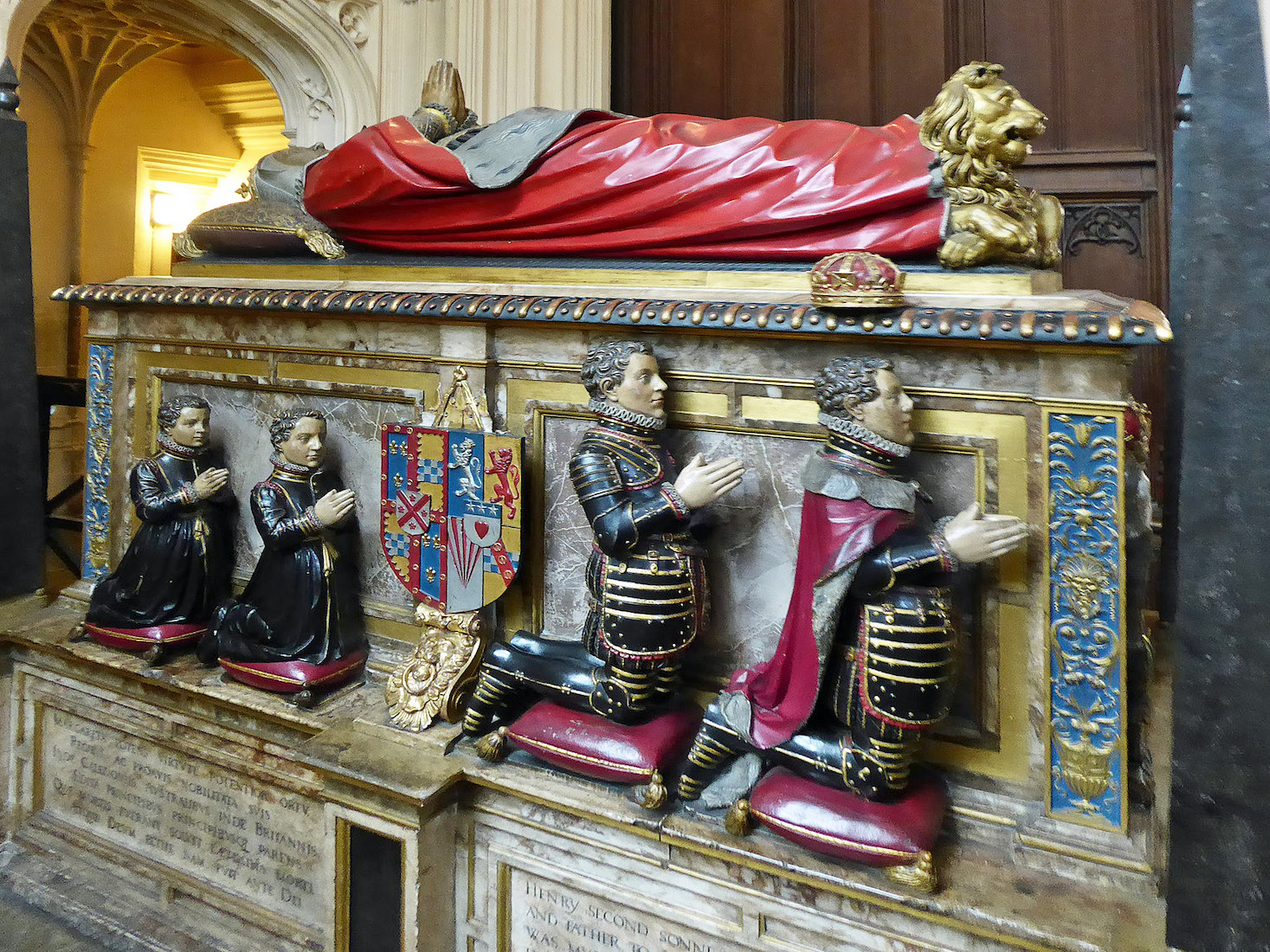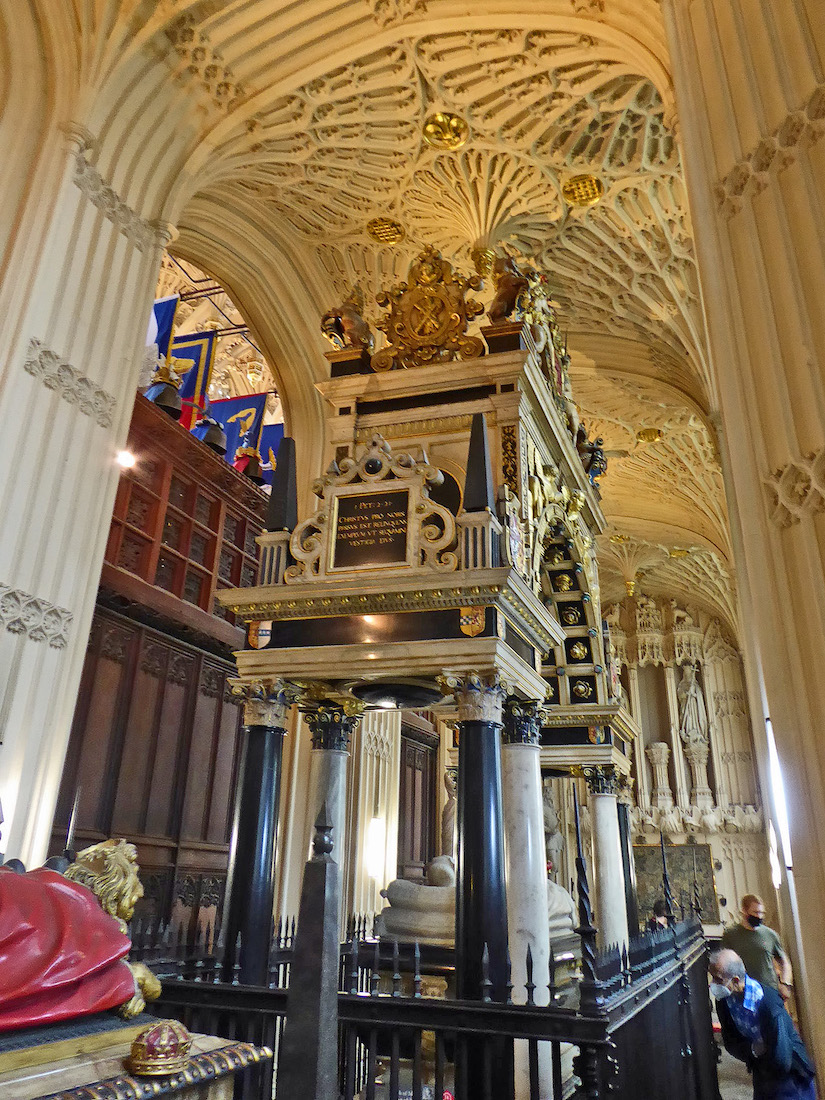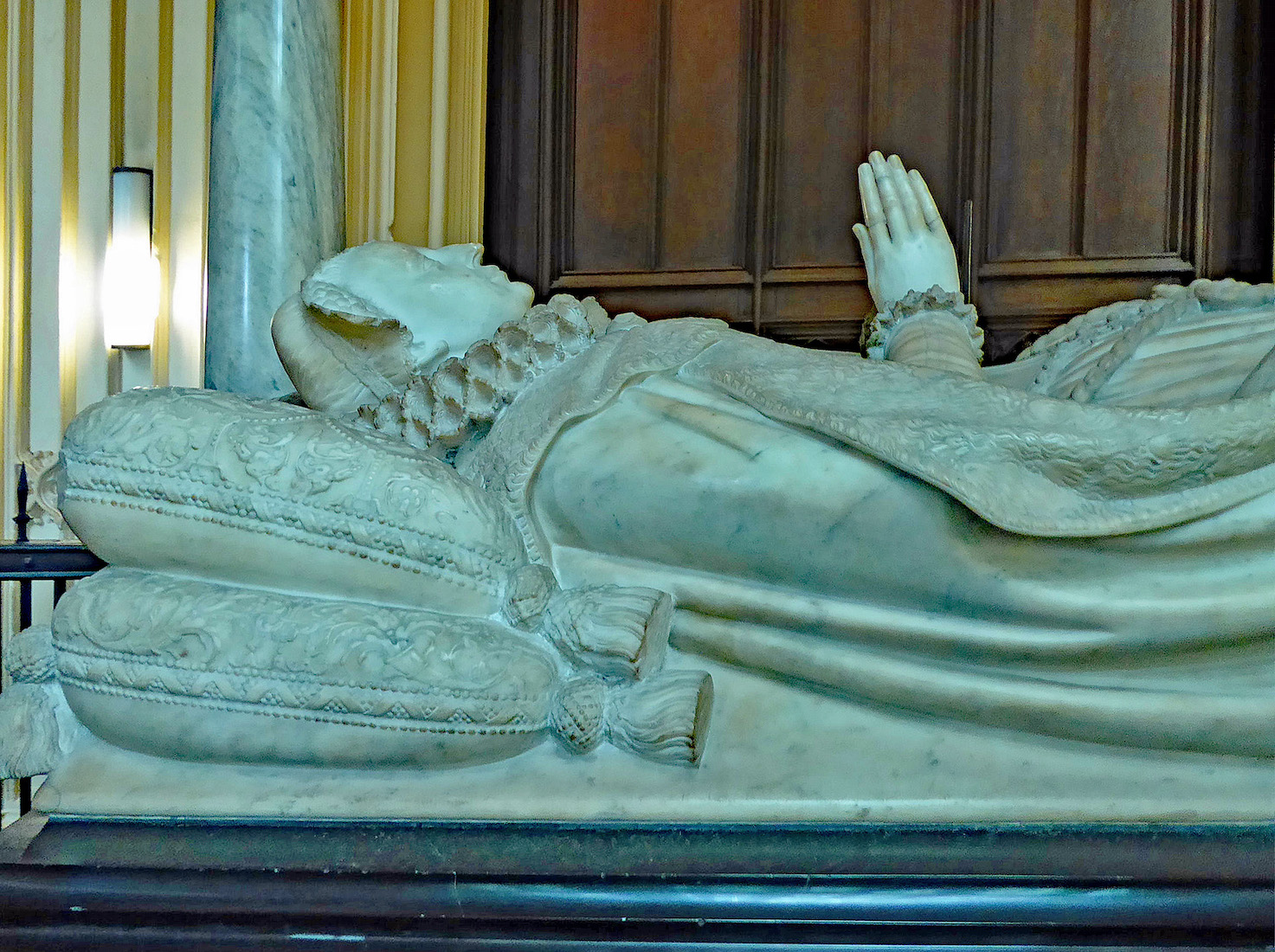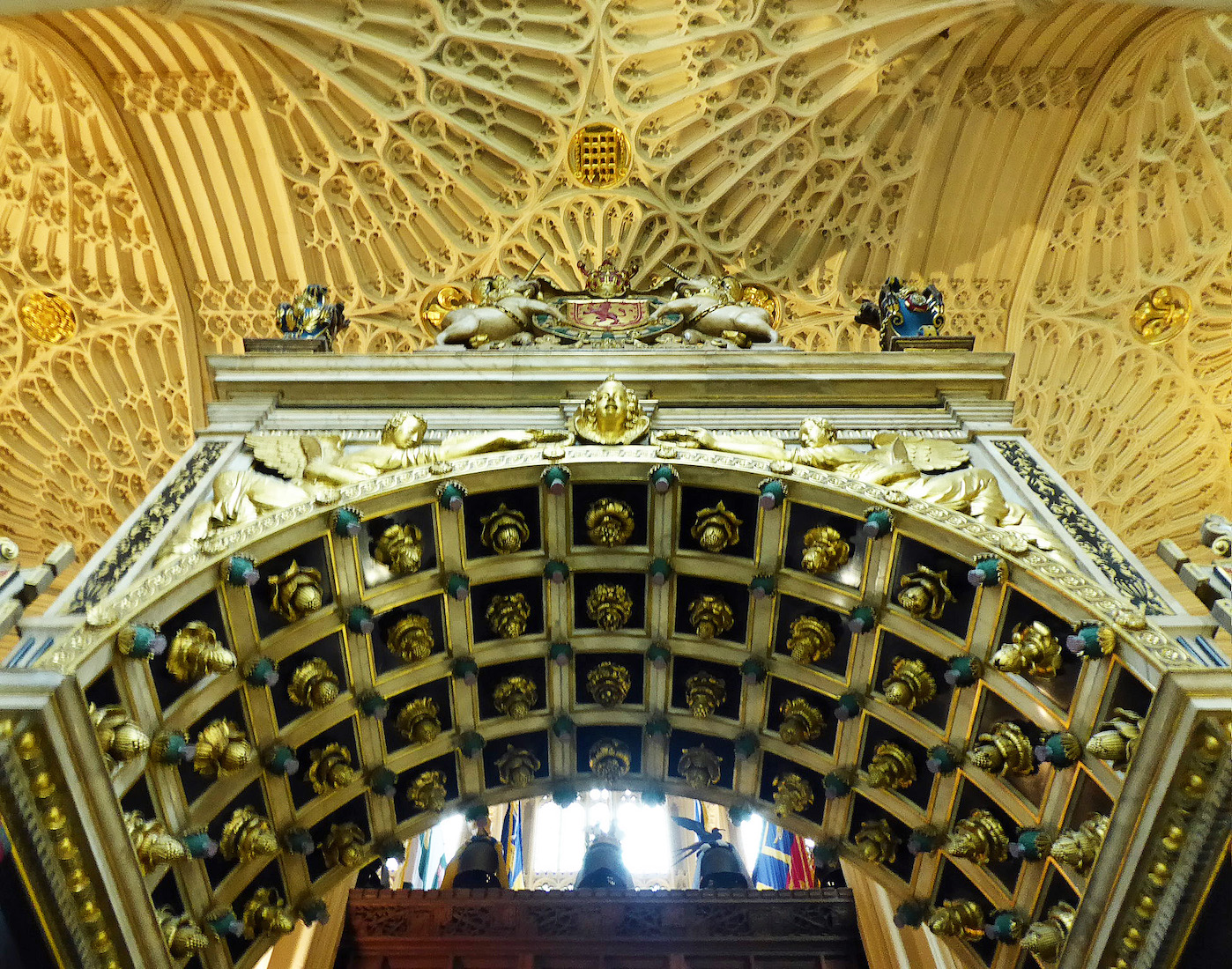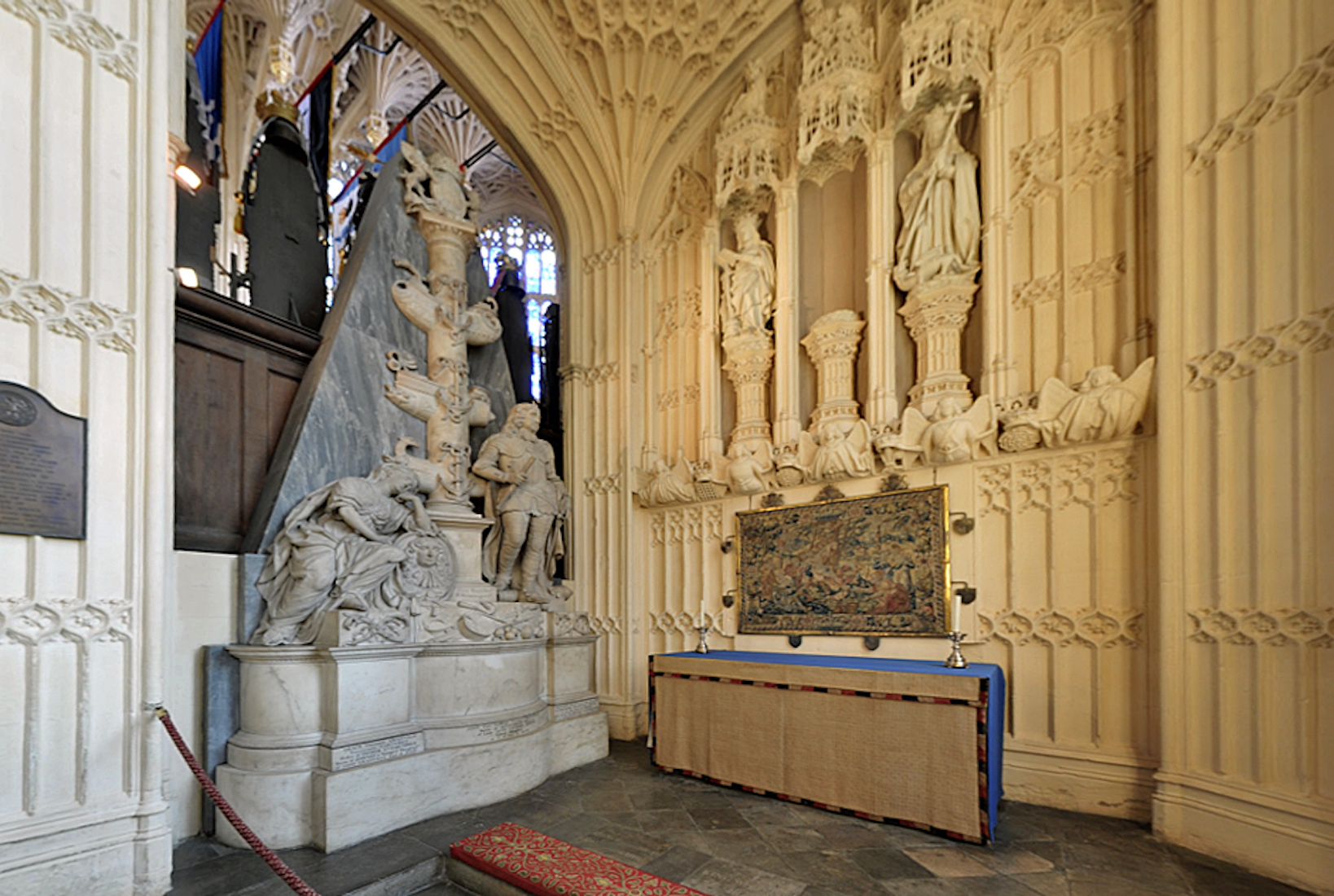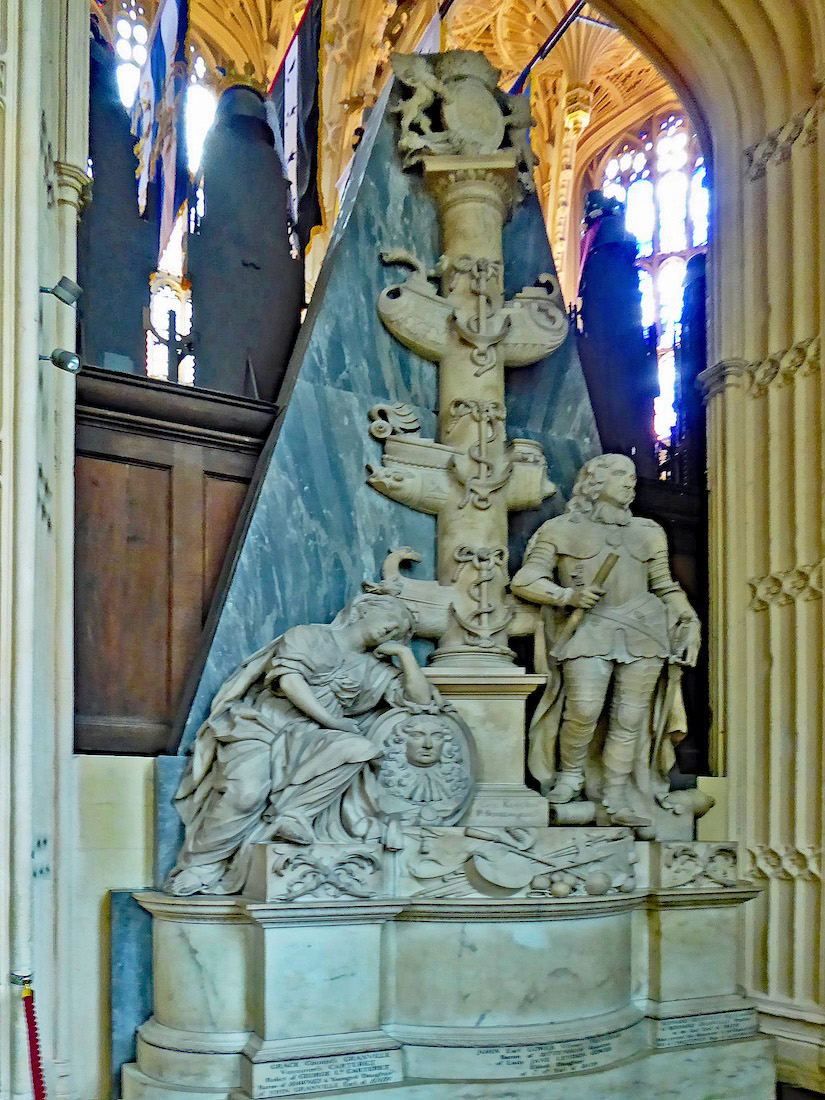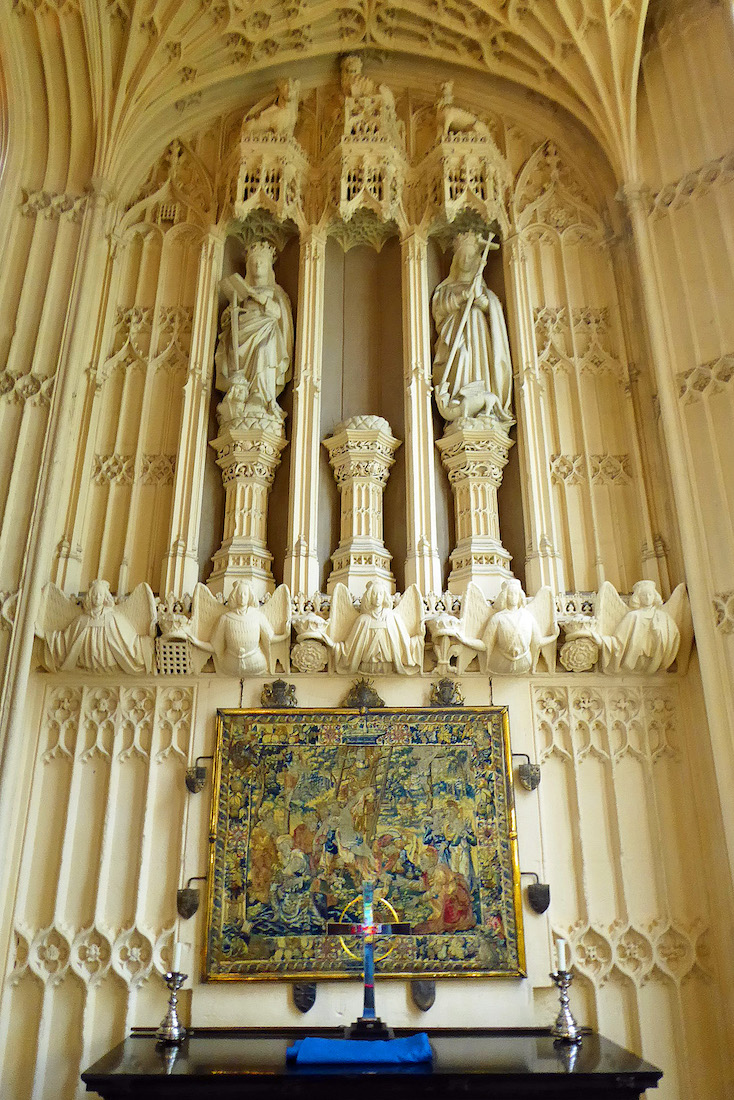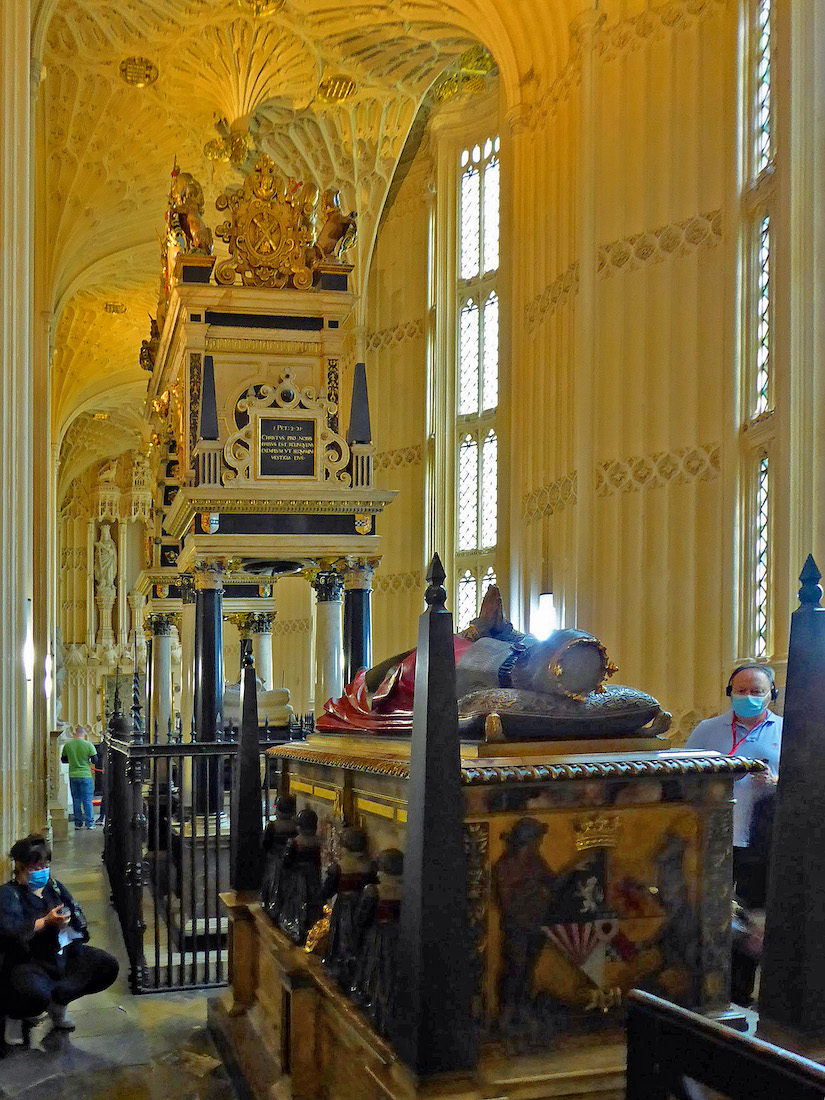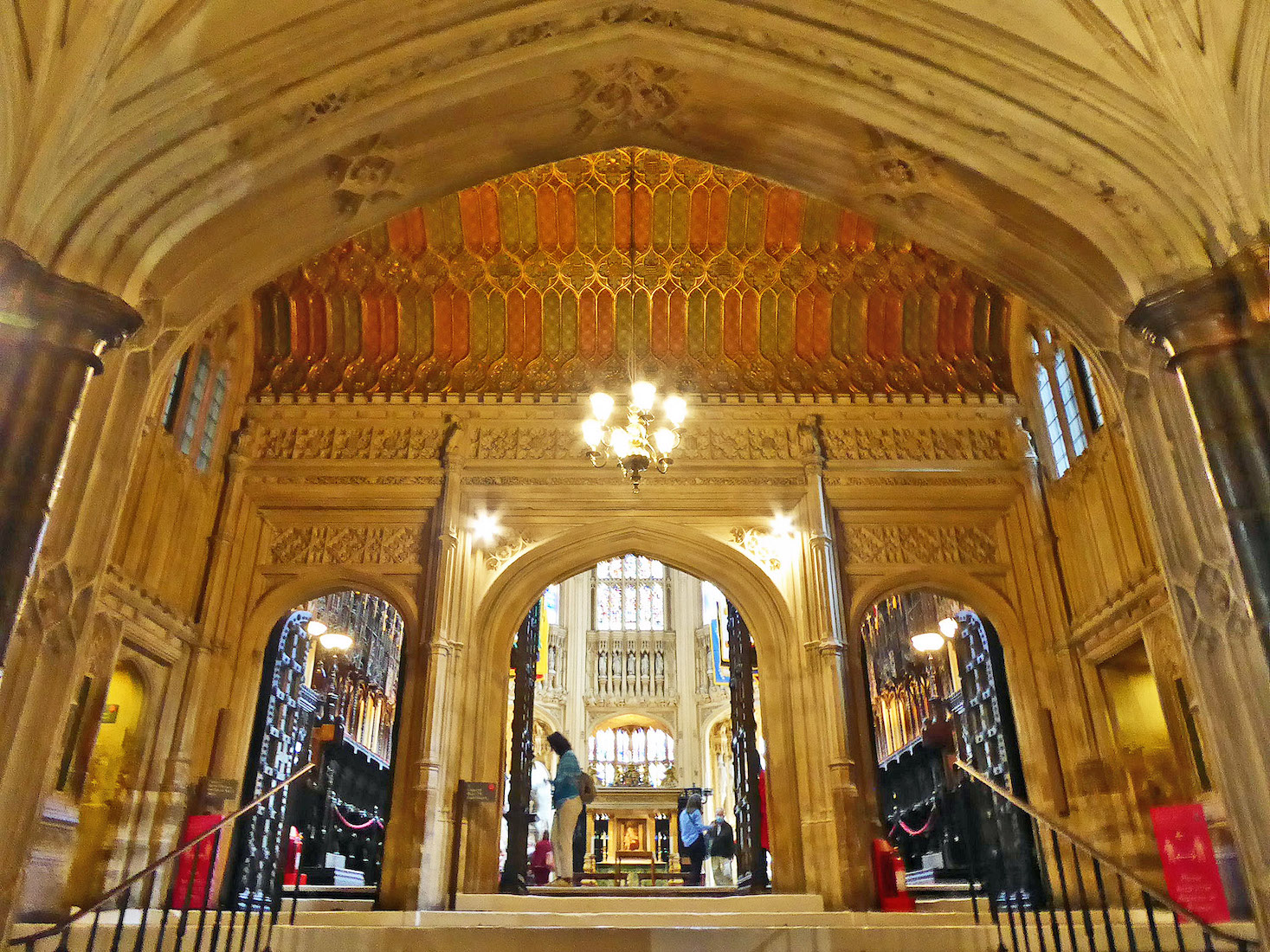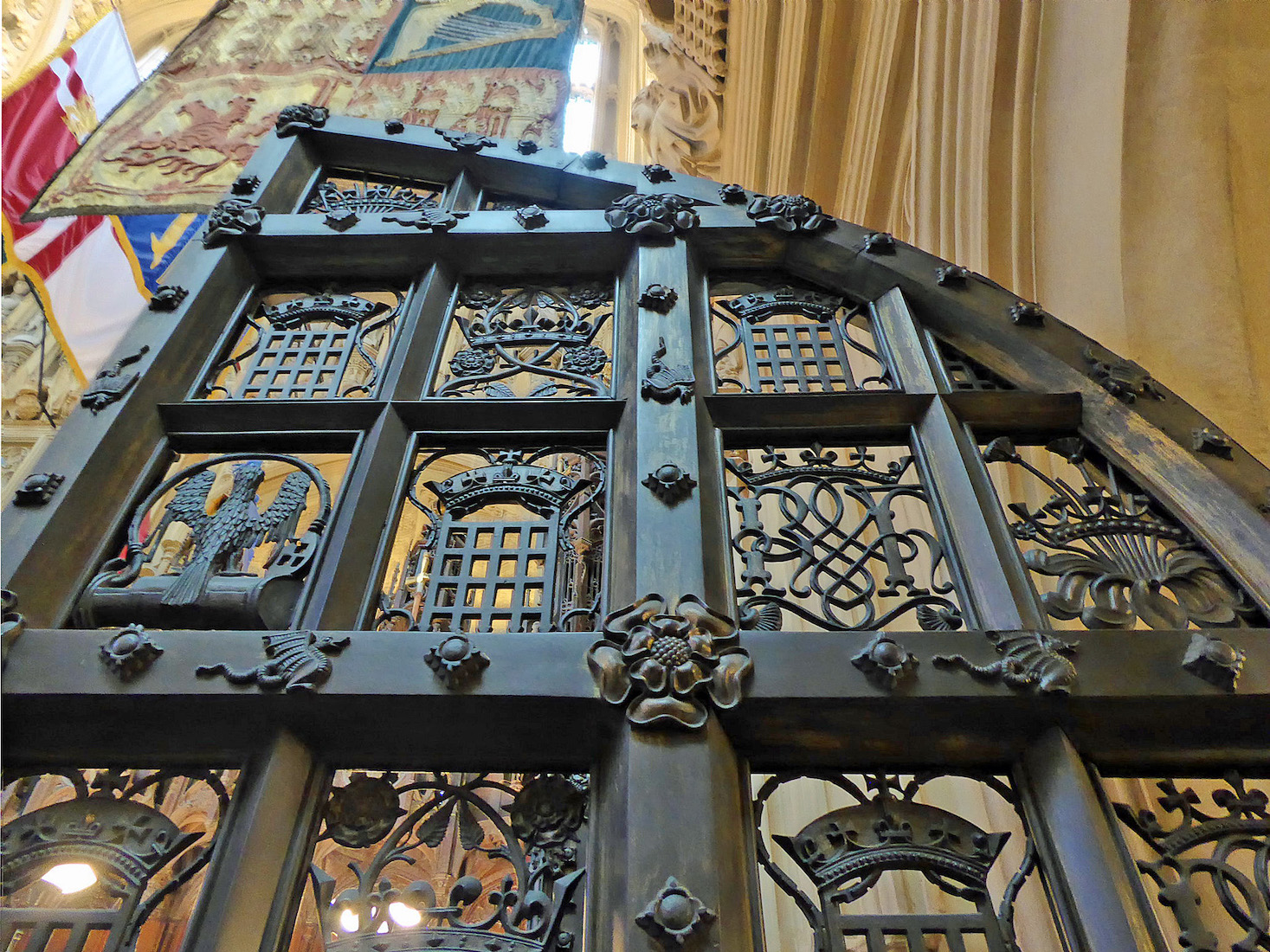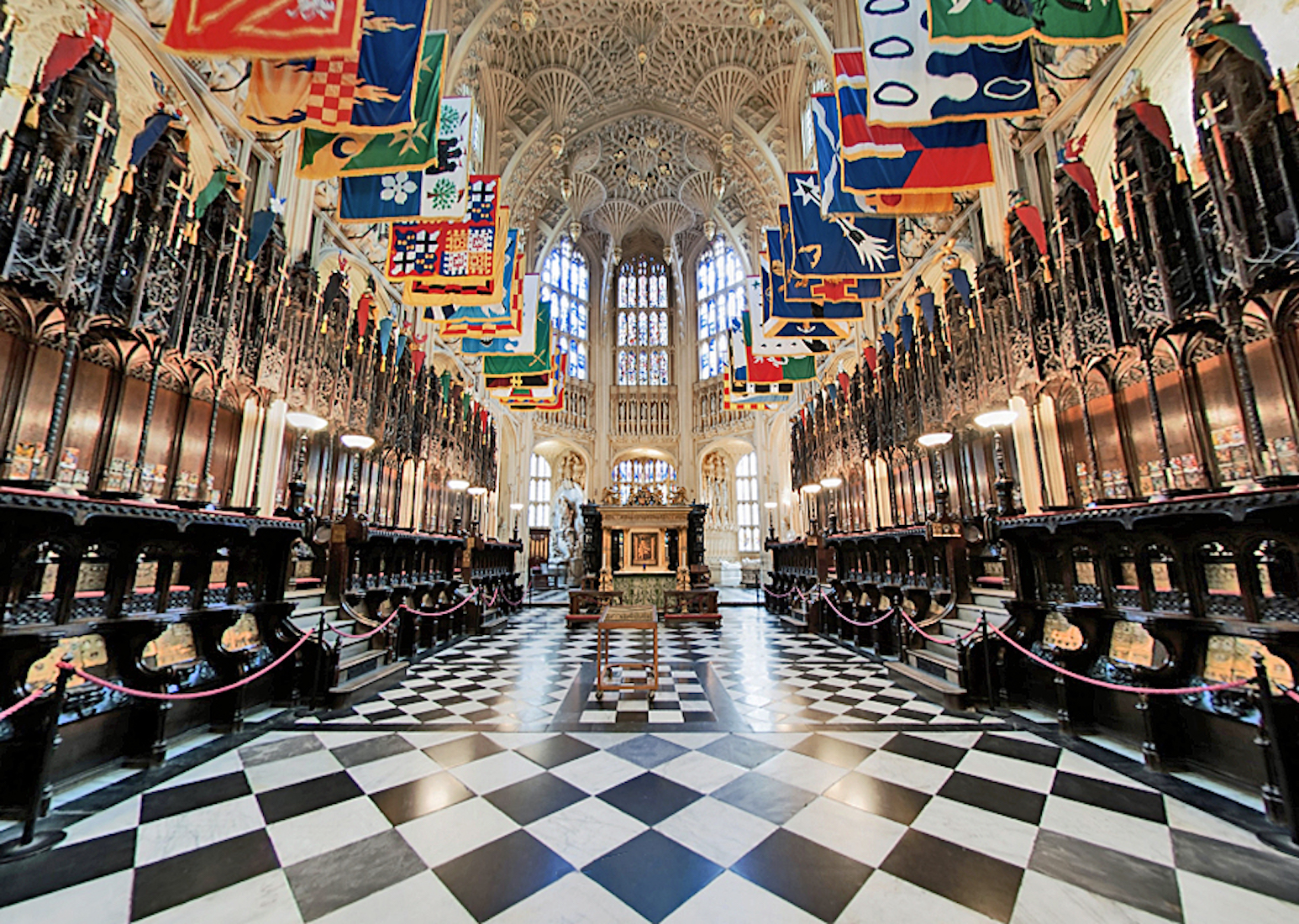G. LADY CHAPEL
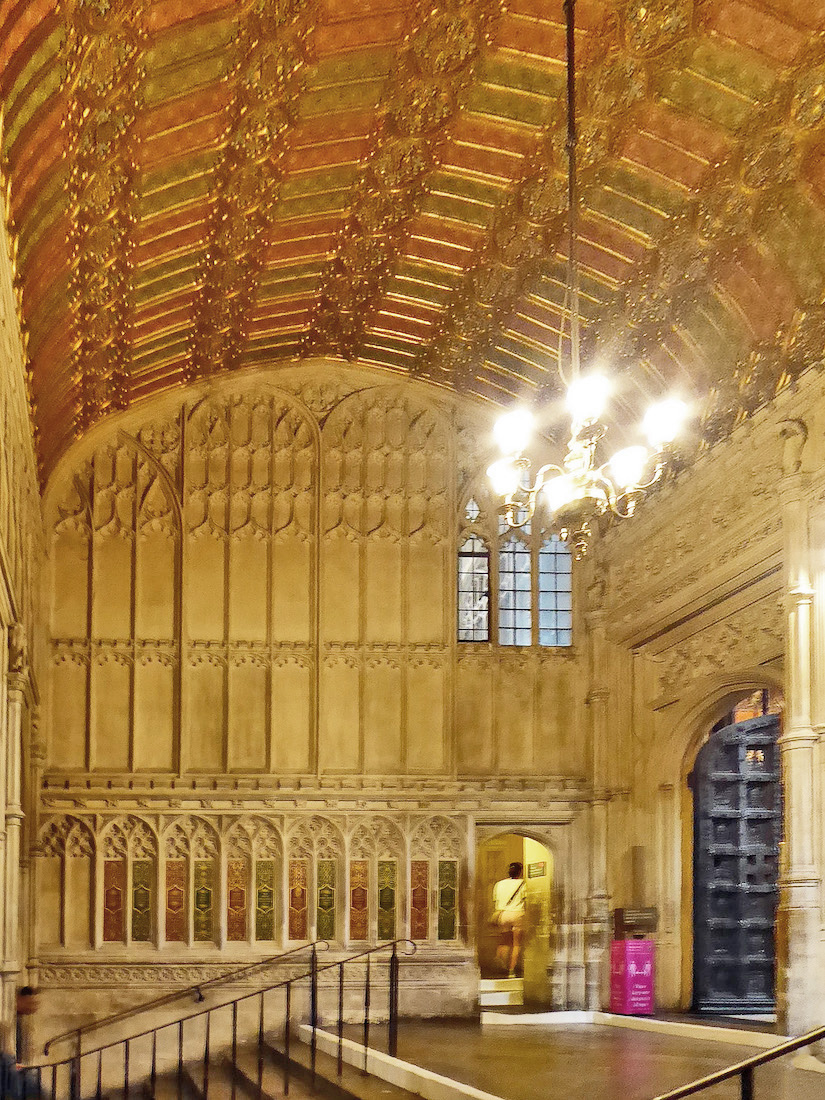
As we come close to the end of our investigation of Westminster Abbey, we walk to the East end of the ambulatory where a wide staircase leads up to the antechapel in front of the Lady Chapel. The antechapel is in the shape of a wide rectangle with the steps leading up through three Gothic arches to the West, and access to the Lady Chapel through corresponding arches to the East. On each side is a flat colonnade with alternating green and maroon rectangular plates, and a door leading through to one of the side aisles of the Lady Chapel. High above each side door is a window with clear glass. INDEX
G2. CEILING OF ANTECHAPEL AMT
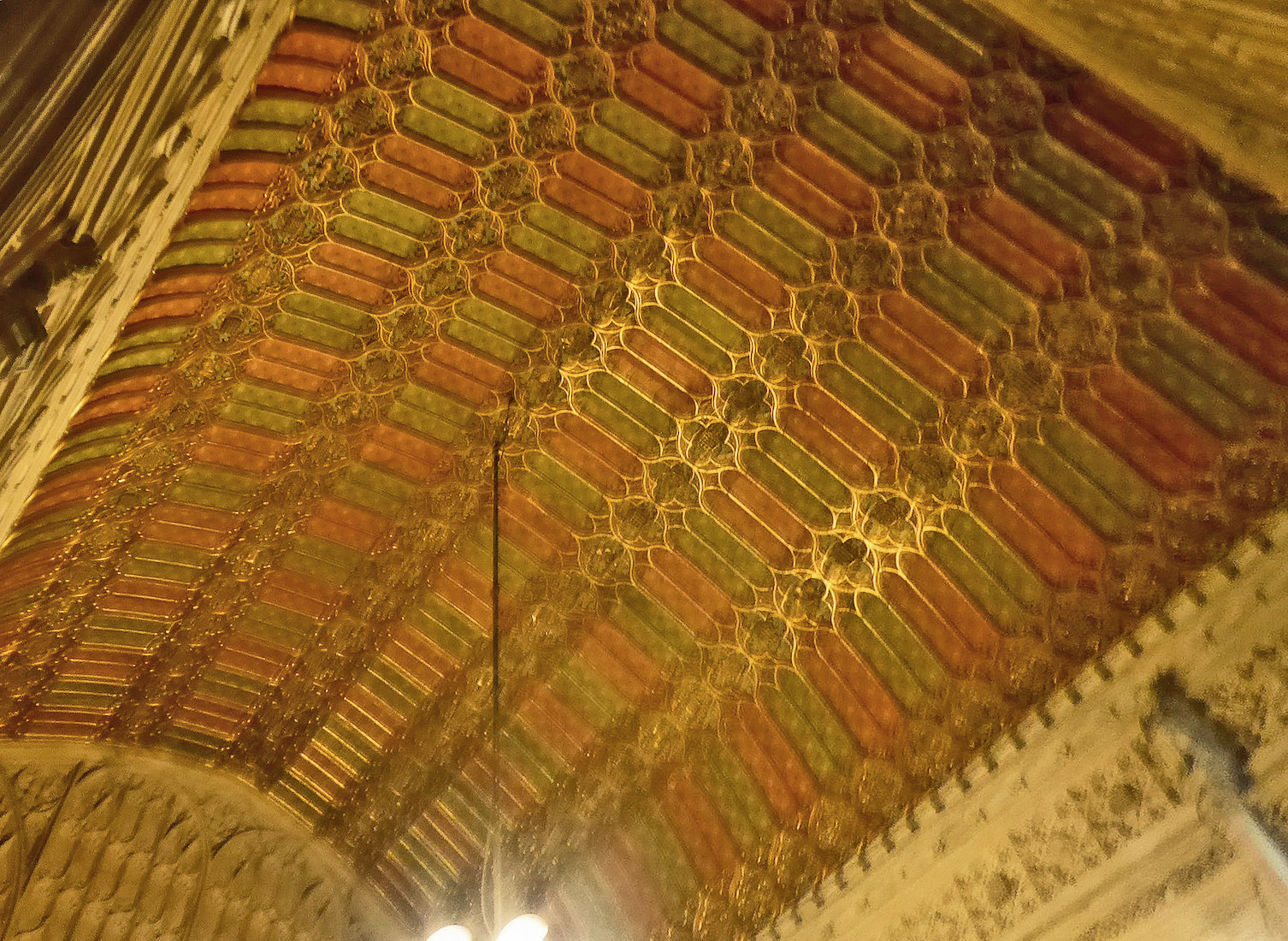
High above us is a shallow barrel ceiling of green and maroon plates resembling the decoration on the side walls.
G3. NORTH AISLE OF LADY CHAPEL AMT
Instead of immediately entering the central aisle of the Lady Chapel, we go through the North door of the anteroom into the North aisle of the Chapel. The outer wall is in fact supported by large columns, but these are hidden by a vertically ribbed wall with outward bays for the clear lattice windows. Above us is some magnificent pendant vaulting, but more of this later. There are some large monuments along the inner wall, and a large tomb in the centre of the aisle, almost obstructing it.
G4. MONTAGUE MONUMENT AND VAULTING AMT AMT
On the inner wall, immediately to our right, is a large monument to Charles Montague (or Mountague) (1661 –1715), 1st Earl of Halifax, Knight of the Garter. At right is a close up view of the wonderful pendant vaulting found in this section of the Abbey.
G5. SAVILE MONUMENT NORTH CHAPEL AMT GSV
Next to the Montague monument on the inner wall is the George Savile monument. George Savile (1633 – 1695), Marquess of Halifax, is buried in the North aisle in the vault first used by General George Monck. Near his grave is this large monument of white, grey and black marble which includes a full face relief portrait medallion. On the top pilasters are two owls, and his coat of arms (with three owls) is also shown.
G6. QUEEN ELIZABETH I TOMB AMT AMT
In the middle of the North aisle is the large tomb of Queen Elizabeth I. Queen Elizabeth I was the daughter of King Henry VIII by Anne Boleyn, and was born at Greenwich in 1533. She succeeded her half-sister Mary I in 1558. Queen Elizabeth was the foundress of the present Collegiate Church of St Peter (the formal title for the Abbey) in 1560, and her long reign was one of the most brilliant in English history.
G7. INNOCENTS’ CORNER AMT (x3)
We sidle past the tomb to arrive at the East end of the North aisle, known as The Innocents’ Corner. Here there are several children’s tombs. On the altar step are the cradle tomb at left, and a tomb guarded by cherubs at right. The cradle tomb is for baby Princess Sophia (died aged 3 days, 1606), daughter of King James I and Queen Anne. The tomb at right is for her sister Mary (1605 – 1607). Behind is an urn containing their supposed remains.
G8. NORTH CHAPEL STATUES AMT
Across the East wall are three statues: St Armel, an unknown sainted king, and St Lawrence. Saint Armel was an early 6th-century holy man in Brittany. Saint Lawrence or Laurence (225 – 258) was one of the seven deacons of the city of Rome under Pope Sixtus II who were martyred in the persecution of the Christians that the Roman Emperor Valerian ordered in 258. He was martyred on a hot gridiron, a fact indicated here.
G9. ACROSS TO THE SOUTH AISLE AMT
We now leave the North aisle, and walk back across the antechapel to the South aisle.
G10. COUNTESS OF LENNOX MONUMENT AMT
The South aisle is a clutter of tombs with hardly any room to move. Right by the entry is the large Countess of Lennox tomb. Margaret Douglas (1515 – 1578), Countess of Lennox, was the granddaughter of Henry VII and widow of James IV of Scotland. On the monument, her recumbent effigy, made of alabaster, wears a French cap and ruff with a red fur-lined cloak, over a dress of blue and gold. On either side of the tomb chest are weepers (small kneeling statues) of her four sons (Charles and Henry and two who died young) and four daughters (all died young).
G11. TOMB OF MARY, QUEEN OF SCOTS AMT
Next along the South aisle is the large and elaborate tomb of Mary Queen of Scots (1542 – 1587). Mary was a daughter of King James V of Scotland and Mary of Guise. Her father died just a week after her birth. A fervent Roman Catholic and a claimant to the English Crown Mary was a great danger to her cousin Elizabeth I. When Mary fled to England after her army was routed in 1568 she was confined by Elizabeth and was finally executed at Fotheringhay Castle in 1587.
G12. MARY, QUEEN OF SCOTS AMT
Mary was first buried in Peterborough Cathedral by Elizabeth’s orders, but in 1612 her remains were brought to the Abbey. The King had erected a magnificent marble tomb for her in the South aisle of the Lady Chapel. There is a fine white marble effigy under an elaborate canopy. She wears a close-fitting coif, a laced ruff, and a long mantle fastened by a brooch. A crowned Scottish lion stands at her feet. The sculptors were William and Cornelius Cure.
G13. TOMB ARCH AMT
The Mary Queen of Scots Tomb has an elaborate canopy arch bearing the Queen’s Coat of Arms.
G14. TOMB OF LADY MARGARET BEAUFORT AMT
Further East along the South aisle, past the Tomb of Mary Queen of Scots, is the much simpler tomb of Lady Margaret Beaufort (1443 – 1509), Countess of Richmond and Derby. She was grandmother of Henry VIII. The tomb has an effigy in gilt bronze of the Countess in her old age, wearing a widow's dress with a hood and long mantle. Her head rests on two pillows, with a design of the portcullis and Tudor rose, and the delicate and characteristic wrinkled hands are raised in prayer. Her friend and confessor Bishop Fisher said of her ‘Every one that knew her loved her, and everything that she said or did became her’.
G15. END OF SOUTH AISLE GSV
It is a pleasure to reach an altar at the end of the South aisle. The simple altar has a tapestry behind and two statues, and there is a large monument to the left. The Countess Grosvenor gave money in 1924 for this altar to be erected, and the framed tapestry above the altar was given in 1929 in her memory.
G16. MONCK MONUMENT AND ALTAR AMT AMT
George Monck (1608 – 1670) was a distinguished naval captain and under Cromwell he was General of the land forces and Admiral at Sea. He was principally responsible for the restoration of Charles II to the throne in 1660 and for his services was created Duke of Albemarle. ••• The statues against the East wall are St Katherine at left and St Margaret at right. St Katherine is crowned, with a book and sword piercing the emperor’s head, and with a broken wheel below. St Margaret is crowned, and has a cross-staff in the mouth of a dragon.
G17. SOUTH AISLE AMT
This concludes our investigation of the South aisle, and we return to the antechapel.
G18. ENTRANCE TO LADY CHAPEL AMT
Before us are the three doors leading through to the Lady Chapel. Known as ‘Chapel of Henry VII’ after its creator, it is also known as the Lady Chapel because it was dedicated in 1503 to the Blessed Virgin Mary. We feel a sense of excitement on entering, as this is the part of the Abbey which people exclaim about! It was even referred to as ‘the Wonder of the World’ by historian John Leland.
G19. LADY CHAPEL GATE AMT
The entrance is flanked by a pair of intricate bronze gates that are decorated with the royal Tudor badges. We note the Tudor rose. In heraldry, the lizard is an emblem of vigilance.
G20. LADY CHAPEL AMT
We step into the Lady Chapel. The simple but dramatic square paving contrasts with the elaborately fine vaulting overhead. The dominant black of the floor tiles and the dark stalls is a complete contrast to the brilliantly coloured banners. And the altar and stained glass before us obviously warrant investigation. The total effect is stunning. Henry VII lavished huge sums on his new Lady Chapel, which was begun in 1503 but not completed until 1516, nearly six years after his death.


